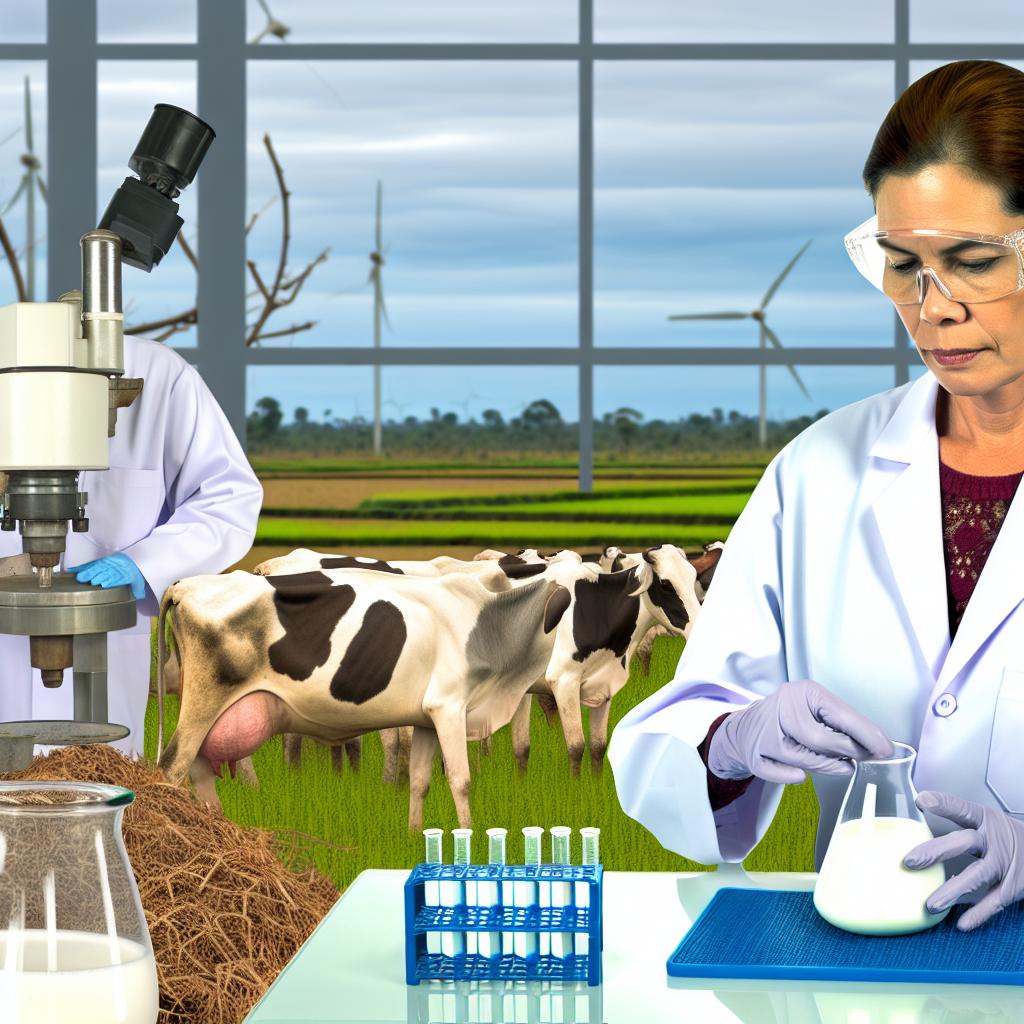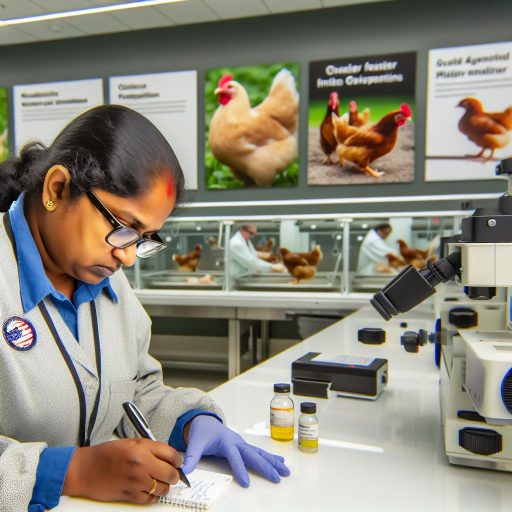Introduction:
Beyond just a delicious treat, dairy science innovations in developing countries play a crucial role in improving the agricultural sector and enhancing food security.
In these nations, where agriculture is a significant contributor to the economy, advancements in dairy science can make a significant impact.
Dairy products are a vital source of nutrition for many people, and innovations in dairy science can help increase production efficiency, improve product quality, and create economic opportunities for farmers.
The Dairy Industry’s Impact on Developing Countries
The dairy industry plays a crucial role in the development of developing countries for various reasons.
Dairy products are rich in essential nutrients like calcium, protein, and vitamins, which are vital for overall health.
The dairy sector provides employment opportunities for millions of people in developing countries.
Dairy farming is a source of income for small-scale farmers, helping them improve their livelihoods.
Dairy products contribute to food security by providing a stable and diverse source of nutrition.
Despite the importance of the dairy industry, farmers in developing countries face various challenges.
Poor storage facilities and transportation systems affect the quality of dairy products.
Farmers struggle to sell their products due to poor market access and low prices.
Farmers lack information and technical support to improve their farming practices.
Erratic weather patterns affect milk production and animal health, leading to losses for farmers.
To overcome these challenges, innovations in dairy science can play a significant role.
Selective breeding can enhance the productivity and quality of dairy animals.
Processing dairy products into value-added items can increase profitability for farmers.
Establishing a cold chain for dairy products can ensure their quality and safety.
Mobile apps can provide farmers with information on best practices, market prices, and weather forecasts.
The dairy industry is essential for the development of developing countries.
Innovations in dairy science can help overcome challenges and improve the livelihoods of dairy farmers in these regions.
Transform Your Career Today
Unlock a personalized career strategy that drives real results. Get tailored advice and a roadmap designed just for you.
Start NowBy addressing issues like infrastructure, market access, and climate change, the dairy sector can contribute significantly to nutrition security and economic growth in developing countries.
Technological Advancements in Dairy Farming:
Artificial intelligence is revolutionizing dairy farming by analyzing data to optimize operations.
AI can monitor cow health, predict diseases, and optimize breeding practices for increased productivity.
Internet of Things devices can track cow behavior, milk production, and environmental conditions in real-time.
IoT helps farmers make data-driven decisions, improve feed management, and enhance overall farm efficiency.
Precision farming involves using technology to tailor farm management practices to individual cows.
Precision farming can optimize feeding programs, reduce waste, and improve animal welfare in developing countries.
Delve into the Subject: Insect Physiology: Fundamental Concepts for Entomologists
Sustainable practices in dairy production are vital for ensuring food security, environmental conservation, and economic development in developing countries.
These practices benefit the farmers and society as a whole.
- Efficient utilization of resources
- Reduced environmental impact
- Promotion of biodiversity
Sustainable farming methods help in optimizing the use of natural resources such as land, water, and energy.
This ensures long-term productivity without depleting the environment.
By adopting sustainable practices, dairy farmers can minimize their carbon footprint and reduce pollution.
This is crucial for mitigating climate change and protecting ecosystems.
Implementing sustainable farming methods can enhance biodiversity on dairy farms.
This leads to healthier ecosystems and improved soil fertility.
This promotes overall environmental sustainability.
Innovations like zero-grazing systems, biogas production, and waste management are crucial for dairy farms.
- Zero-grazing systems
- Biogas production
- Waste management
Zero-grazing systems involve keeping dairy cattle in enclosed spaces where they are provided with feed and water.
This helps in preventing overgrazing, soil erosion, and nutrient depletion.
Transform Your Career Today
Unlock a personalized career strategy that drives real results. Get tailored advice and a roadmap designed just for you.
Start NowBiogas production involves using dairy cow manure to generate renewable energy for cooking and heating.
This not only reduces waste but also contributes to sustainable energy practices.
Effective waste management in dairy farms includes recycling cow manure into organic fertilizers.
This minimizes water pollution and ensures the proper disposal of any waste products.
This helps in maintaining a clean and healthy environment.
Sustainable practices in dairy production are crucial for the development of developing countries.
Implementing innovative methods like zero-grazing systems, biogas production, and waste management benefit dairy farmers.
These methods also contribute to environmental conservation and economic growth.
Learn More: Volunteer Opportunities with 4-H Youth Programs
Quality Control and Food Safety in Dairy Products
Maintaining quality standards and food safety is crucial in dairy products.
Innovations in milk testing ensure the quality of products.
Pasteurization techniques have been improved for better safety.
Advanced packaging methods help in preserving quality and freshness.
Importance of Maintaining Quality Standards and Food Safety in Dairy Products
In developing countries, ensuring the quality and safety of dairy products becomes even more critical.
Dairy products are highly perishable and can easily be contaminated if proper measures are not followed.
This can lead to foodborne illnesses and diseases, which can have severe consequences on public health.
Hence, maintaining stringent quality control measures and ensuring food safety is of utmost importance.
Innovations in Milk Testing
With advancements in technology, dairy farmers and producers in developing countries can now utilize rapid testing methods to check the quality of milk.
These tests can detect harmful bacteria, pathogens, and contaminants in milk, ensuring that only safe and high-quality products reach consumers.
The use of portable testing devices has made this process more efficient and cost-effective, benefiting both producers and consumers.
Transform Your Career Today
Unlock a personalized career strategy that drives real results. Get tailored advice and a roadmap designed just for you.
Start NowPasteurization Techniques
Pasteurization is a crucial step in dairy processing, as it helps in killing harmful bacteria and extending the shelf life of milk and dairy products.
In developing countries, traditional pasteurization methods may not always be sufficient to ensure complete safety.
Innovations such as ultra-high temperature (UHT) pasteurization and microfiltration have been introduced to enhance the effectiveness of pasteurization and improve product safety.
These techniques help in maintaining the nutritional value of milk while ensuring its safety for consumption.
Packaging Innovations
Proper packaging plays a significant role in maintaining the quality and freshness of dairy products.
In developing countries, innovative packaging solutions are essential.
Vacuum packaging, modified atmosphere packaging (MAP), and aseptic packaging are some of the advancements in packaging technology that help in extending the shelf life of dairy products and preventing contamination.
These packaging methods also reduce the need for preservatives, making the products safer and more natural for consumers.
Quality control and food safety are paramount in the dairy industry, especially in developing countries where resources may be limited.
By implementing innovative technologies in milk testing, pasteurization, and packaging, dairy producers can ensure that their products meet the highest quality standards.
Consumers can have peace of mind knowing that the dairy products they consume are of the best quality and adhere to strict food safety regulations.
Delve into the Subject: How Pest Control Advisors Protect Crops
Dairy product innovations:
Explore the development of new dairy products tailored to the needs and preferences of consumers in developing countries.
Discuss innovations in processing techniques, flavors, and packaging to increase market demand.
In developing countries, dairy product innovations play a vital role in meeting the evolving needs and tastes of consumers.
As the dairy industry continues to grow, there is an increasing demand for products that are not only nutritious but also cater to specific dietary requirements and cultural preferences.
One of the key areas of focus in dairy product innovation is the development of new products tailored to the needs of consumers in developing countries.
This includes products that are fortified with essential nutrients to address malnutrition and products that cater to specific dietary preferences, such as lactose-free or low-fat options.
In addition to developing new products, innovation in processing techniques is also crucial in ensuring the quality and safety of dairy products.
New processing technologies can help extend the shelf life of dairy products, improve their nutritional content, and enhance their sensory attributes.
Transform Your Career Today
Unlock a personalized career strategy that drives real results. Get tailored advice and a roadmap designed just for you.
Start NowFlavor innovation is another important aspect of dairy product development.
By experimenting with different flavors and combinations, dairy producers can create products that appeal to a wide range of tastes and preferences.
This can help increase consumer interest and drive sales in developing countries.
Packaging innovation is also key in increasing market demand for dairy products.
Packaging can help extend the shelf life of products, improve convenience for consumers, and enhance the overall consumer experience.
For example, single-serve packaging is popular in developing countries as it allows consumers to easily consume dairy products on the go.
Overall, dairy product innovations in developing countries are essential for meeting the diverse needs and preferences of consumers.
By exploring new product development, processing techniques, flavors, and packaging, dairy producers can expand their market reach and contribute to the growth of the dairy industry in these regions.
Uncover the Details: The Future of Poultry Science and Technology

Government Policies and Support for Dairy Industry:
Analyze the role of government in promoting dairy science innovations through funding, research, and training programs.
Highlight successful case studies of government initiatives that have boosted the dairy industry in certain developing countries.
Government Funding:
- Government funding plays a crucial role in supporting research and development in the dairy industry.
- By allocating financial resources to dairy science innovations, governments can help drive progress and growth.
- Funding can be directed towards research projects, infrastructure development, and training programs for dairy farmers.
- Access to government funding enables scientists and researchers to explore new technologies and practices in dairy farming.
Government Research Support:
- Government support for research activities in the dairy sector can lead to breakthrough innovations and advancements.
- Encouraging collaboration between academia, industry, and government can foster a culture of innovation in dairy science.
- Research grants and scholarships provided by the government can incentivize scientists and students to pursue dairy-related studies.
- Investing in research can help address challenges faced by the dairy industry and improve productivity and sustainability.
Government Training Programs:
- Training programs organized by the government can enhance the skills and knowledge of dairy farmers and industry professionals.
- Workshops, seminars, and capacity-building initiatives help individuals stay updated on the latest trends in dairy science.
- Technical training on new equipment, technologies, and farm management practices can improve efficiency and profitability in dairy operations.
- Government-sponsored training programs also promote best practices in animal welfare, milk quality, and environmental sustainability.
Case Studies of Government Initiatives:
- In India, the National Dairy Development Board (NDDB) has played a pivotal role in revolutionizing the dairy industry.
- The NDDB’s Operation Flood program transformed India from a milk-deficient nation to the world’s largest milk producer.
- The Kenyan government’s Dairy Goat Project has empowered small-scale farmers by promoting goat milk production and marketing.
- In Brazil, the More Milk Program implemented by the government has increased dairy productivity and improved the livelihoods of farmers.
Collaboration and partnerships in dairy science:
Collaboration among researchers, industry professionals, and policymakers plays a crucial role in driving innovation in the dairy sector.
When different stakeholders come together, they can combine their expertise and resources to tackle key challenges and drive progress.
Importance of collaboration:
- Pooling resources and knowledge leads to more effective research and development efforts.
- Collaboration ensures that solutions are practical and aligned with industry needs.
- Bringing together diverse perspectives can lead to innovative breakthroughs.
- Collaboration fosters knowledge sharing and capacity building within the sector.
- By working together, stakeholders can advocate for policy changes that support the dairy industry.
Successful partnership models:
Several successful partnership models have emerged in developing countries that have driven advancements in dairy science.
- Public-private partnerships: These collaborations leverage the strengths of both sectors to drive innovation and market-driven solutions.
- Academic-industry partnerships: Universities and research institutions collaborate with industry partners to conduct research and implement findings.
- International collaborations: Partnerships with international organizations bring global expertise and funding to local dairy projects.
- Farmers’ cooperatives: These grassroots partnerships empower small-scale dairy farmers to collectively invest in research and technology.
- Government-industry partnerships: Policymakers work closely with industry stakeholders to create supportive regulatory frameworks for dairy innovation.
These partnership models have yielded tangible results, such as improved dairy productivity, quality, and sustainability in developing countries.
Dairy Science Innovations in Developing Countries
Dairy science innovations in developing countries play a crucial role in transforming the dairy industry.
The adoption of new technologies and practices has significantly improved milk production, processing efficiency, and product quality.
These advancements have the potential to boost agricultural productivity, enhance food security, and create new economic opportunities for rural communities.
By leveraging dairy science innovations, developing countries can address challenges such as malnutrition, poverty, and unemployment.
The integration of sustainable practices and research-driven solutions can lead to long-term benefits for the dairy sector.
Transform Your Career Today
Unlock a personalized career strategy that drives real results. Get tailored advice and a roadmap designed just for you.
Start NowThis will support the growth of smallholder farmers and agribusinesses.
It is essential for policymakers, researchers, and industry stakeholders to collaborate and invest in the further development of dairy science innovations.
The impact of dairy science innovations extends beyond the dairy industry alone.
It has the power to stimulate broader agricultural transformation, promote sustainable development, and improve livelihoods in developing countries.
By prioritizing the adoption of innovative practices, these nations can pave the way for a more resilient, inclusive, and prosperous dairy sector.




